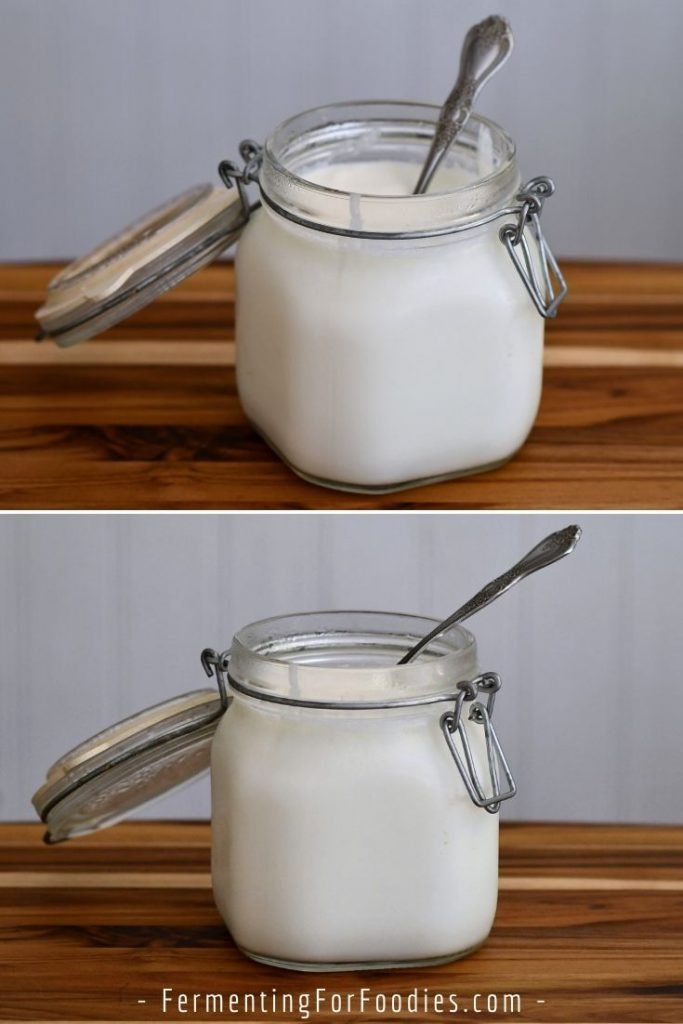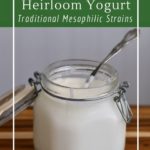There are many types of yogurt that culture at room temperature. Here is an overview of the differences between store-bought and heirloom yogurt as well as information about how to make heirloom yogurt.

There are many types of heirloom yogurt that culture at room temperature. These mesophilic yogurt cultures are WAY easier to make than heat set yogurt.
The final yogurt isn’t exactly like store-bought yogurt. It’s a bit like comparing an heirloom tomato with store-bought beefsteak tomato; they are both good, but they aren’t exactly the same.
Store-bought versus heirloom yogurt
Store-bought yogurts are usually quite similar. While some of them might be strawberry flavored and others are French vanilla… they share the same types of culture.
Here are a few differences between store-bought and heirloom yogurt:
- Culture: Typical store-bought yogurts are a mix of bacterial strains. They almost always contain L. acidophilus plus a few other strains of Lactobacillus and Bifidobacterium. Heirloom yogurts contain a mix of different bacterial strains and often include strains of yeast.
- Temperature: Store-bought yogurts are thermophilic, so you need to keep the milk warm in order to culture them. These heirloom yogurts are all mesophilic and will set at room temperature.
- Flavor: The flavor of store-bought yogurt can be mild or strong, depending on how long it was cultured. Often thickeners are added to improve the consistency without creating a stronger flavored yogurt. Mesophilic yogurts all have different flavors and consistencies, depending on the variety.
Types of Heirloom Yogurt
There are a number of different heirloom yogurt cultures, each with its own unique flavor and consistency. They come from different regions, likely arising from local variations in bacteria and yeast.
Some common types of mesophilic yogurts are:
- Filmjolk: a thick, mild, and cheesy yogurt from Nordic countries.
- Matsoni: a slightly thickened and mild yogurt from the Caucasus.
- Kefir: milk kefir is similar to matsoni, with a stronger, sour flavor. It is cultured from grains that are formed by a symbiotic culture of bacteria and yeast. It is also from the Caucasus.
- Viili: a gelatinous and ropey product that has a sweet flavor. It comes from Scandinavia.
- Piimä: a sour, buttermilk-like beverage also from Scandinavia.
The hardest part about making mesophilic yogurt is finding the culture. If you don’t know anyone who has a culture to share, then you can always buy heirloom yogurt cultures online.
Matsoni Yogurt
Learn all about making matsoni yogurt using a room temperature heirloom yogurt culture. Matsoni yogurt is a thick and creamy yogurt that has a mild flavor. It is delicious, probiotic, and easy to make at home.
- Prep Time: 5 minutes
- Total Time: 5 minutes
- Yield: 2 cups 1x
- Category: Breakfast
- Method: Fermented
- Cuisine: Caucasus
- Diet: Gluten Free
Instructions
- Combine milk and matsoni culture in a clean glass container.
- Leave it somewhere warm for 12-24 hours (until set). It prefers temperatures between 21-25 C (70-77 F), so stash it above the fridge or beside the hot water heater.
- When it has thickened, store it in the refrigerator for up to 1 month.
- Once you have bought matsoni yogurt culture, you can keep reculturing it. To keep the culture active, either make matsoni once a week or freeze the culture for up to 4 months. I usually freeze 1 cup of yogurt every time I make a batch so I can keep a vigorous culture.
- See the notes below for options on how to make a thicker yogurt, and how to make yogurt cheese.
Notes
- I recommend sharing the culture with your friends and family, so you don’t have to worry if you go away on holiday or take a break from culturing. It’s also a great way to ensure that you always have access to a good culture.
- Matsoni is thickest when eaten within the first two days after culturing. However, if you use too much culture or leave it on the counter for too long, it will separate into curds and whey. It’s still fine to eat, but you will need to stir the whey into the yogurt. Alternatively, over-cultured matsoni is perfect for yogurt cheese! Here are instructions on how to make labneh (yogurt cheese).
- Store-bought yogurt is thicker because it starts with denatured milk proteins. This method can be used to make thicker matsoni yogurt. Start by heating the milk to 80 C (176 F) which denatures the whey proteins and allows them to naturally gel and thicken. Then the milk needs to be cooled to 25 C (77 F) before stirring in the culture. Follow the usual culturing instructions.







Hi Emillie,
Where do you find the culture for matsoni yogurt? That sounds intriguing.
I don’t have matsoni culture right now… but I might know some who does. I’ll connect you in Facebook.
Do you still have connections who might have matsoni culture to share? I live in Scandinavia and have been looking for matsoni for months without success.
Sorry, I’m not sure about trying to mail something like that overseas. Have you tried looking online or try posting in an online forum?
Do you use raw milk? I have access to good quality raw goat milk. It’s too much fuss for me to make Bulgarian and Greek yogurt. If you use raw milk how do you know that the culture is still ok for what you are doing. In Sweden I could buy filmjölk for less than 1 euro, make yoghurt 10-15 times, then buy a new one. It was much milder flavor than from store bought, I liked this mild flavor but now when I don’t have access to filmjölk I can only buy culture online which is much more expensive if the culture degrades after a few batches
Hi Ann, I do not have access to raw milk. And you’re right, if you heat the milk for some times of heat-set cultures it will kill the cultures in raw milk. I’m not sure how the culture in your raw milk will compete with the filmjolk culture… the only way to know would be to test it as it really depends on the exact strains of bacteria. If you want to save the culture, freeze a 1/4 cup right after you finish culturing it. Then you’ll preserve the bacteria when it is very vigorous.
Cheers, Emillie
I can vouch for how good Matsoni is. Alas, I have limited space and funds for the milk, and am committed to culturing both kefir and filmjolk, so it was a one-time treat for me, but one I will cheerfully restart if I’m ever able.
Thanks! Look forward to it.
I used to livein Georgia, and I absolutely love matsoni! We used to trade our neighbours fresh matsoni and homemade cheese for our Swedish cinnamon buns up in Svaneti. Their cow often roamed our garden and most afternoons we had to make a show of chasing her back to their garden. Not that we minded her, but they were quite worried we’d find the cow a nuisance. That matsoni was divine, and I’m afraid the cultures one can find on the internet just won’t do. All the matsoni I tasted in Georgia (apart from the bland supermarket versions) were quite yeasty, and very tangy. They were way thicker than Swedish filmjölk, which Iove too.
I got my matsoni culture from a friend, and I don’t know how it compares to real Georgian Matsoni or store-bought culture. However, it isn’t that sour, so perhaps more like what you find on the internet? My husband is of Georgian heritage and visiting is definitely on our bucket list! Maybe I’ll bring back some real matsoni culture. Thanks for sharing.
If you are ever able to find some Georgian Matsoni, I would love to connect with you to get some, if you can share!
Where do you live? I do have access to Matsoni… however, I’m in Canada. Check on Amazon as there are a number of international sellers. And if you happen to be in Canada, then send me a message on FB.
You are too kind! I actually live in Colorado, USA. I will check around! Keep up the good work!
Nice! I have an Uncle in Boulder. It’s a beautiful area.
Just in case this helps anyone, I came across this starter. Cultures for Health heirloom yogurt
I am learning about these types of yogurts after accidentally getting a yeasty batch of yogurt with “stringy/slimy/snotty” consistency & google searching to figure out what happened.
So nice to hear about the flavor of heirloom yogurts that people have experience with!
Yes! They’re great for culture which is why I advertise for them in my sidebar. 🙂
How does the flavor change if you use more culture or let it sit longer? I’ve been making Viili yogurt, and it calls for 1/4 c per quart, and I incubate for 24 hours to get rid of the lactose (so it doesn’t hurt to eat). Also, more starter usually yields a thicker consistency, which I prefer, but flavor is also really important. We prefer a milder yogurt. What would happen to the flavor if I made these changes?
The flavour will always get more sour the longer it ferments… and that is because it is consuming the lactose. If you want a milder yogurt, try matsoni which is naturally mild (although not very thick).
Be careful with buying Matsoni. I bought some Matsoni starter back in May. I live in Tucson.Arizona, and by the time I got my culture at the end of May out days was already 100 degrees Fahrenheit and my poor Matsoni starter was dead on arrival.
So in September when the temperature moderates I will be buying it again
Would love to have Matsoni that will ferment at room temperature
Wow! That is good advice. I hadn’t thought of cultures dying during shipping because of the heat. (I’m in the PNW). Thanks for sharing!
As I said my Matsoni arrived dead in May.
Recently I met a woman with Armenian ancestry and she gave me Matsoni starter and shared some with a Friend.
After the extreme heat in Arizona I will be ordering more Matsoni, and probably Filmjolk
I froze the culture to keep it active. Do I let it come to room temp before using, for a new batch?
I usually pop my yogurt culture into my fridge the day before I want to use it, then it will be defrosted. I usually use refrigerator cold culture as it’s so little per batch it doesn’t make much of a difference. Cheers!
Thanks so much for your speedy response. I’ll pop it in the fridge right now:)